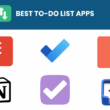Table of Contents Show
Are you constantly struggling to manage your time effectively? Do you find yourself overwhelmed with tasks and deadlines? Look no further! In this blog post, we will share 10 expert-approved time management hacks that will help you increase your productivity and achieve your goals.
From prioritizing tasks and setting clear goals to eliminating distractions and optimizing email management, these tips will revolutionize the way you approach time management. Get ready to take control of your schedule and make the most out of every minute!
1. Prioritize your tasks
Prioritizing your tasks allows you to make progress toward your goals and maximize productivity. By breaking down larger tasks into smaller, manageable steps, you can stay organized and motivated.
You can prioritize your tasks with the following steps:
a. Make a to-do list
Get organized and increase your productivity by creating a comprehensive to-do list that outlines all of your tasks for the day or week.
b. Identify your most important tasks
Identify your most important tasks to prioritize your workload by determining which tasks are most crucial and need to be completed first.
- Prioritize tasks based on urgency and importance
- Focus on high-value activities that align with your goals
- Eliminate or delegate low-priority tasks to free up time
In order to effectively manage your time, it is crucial to identify and prioritize your most important tasks. By focusing on the following key strategies, you can increase productivity and achieve greater success in both personal and professional endeavors:
- Determine Urgency & Importance: Assess each task based on its urgency and importance level.
- Align with Goals: Identify which tasks directly contribute to your long-term goals.
- Delegate or Eliminate Non-Essential Tasks: Delegate low-priority responsibilities or eliminate them altogether.
- Allocate Time Wisely: Dedicate sufficient time for critical tasks while avoiding excessive multitasking.
By implementing these strategies, you can ensure that you are investing your time wisely in activities that truly matter, resulting in increased productivity and overall effectiveness in achieving desired outcomes
Break down large tasks into smaller ones
Break down large tasks into smaller ones to make them more manageable. This will help you stay focused and motivated, ultimately increasing your productivity.
- Identify the main components of the task and break them down into smaller steps.
- Set specific goals for each step to keep yourself on track.
- Prioritize these smaller tasks based on their importance and deadlines.
By breaking down large tasks into smaller ones, you can tackle them more efficiently and feel a sense of accomplishment as you complete each step.
2. Set clear goals
In order to manage your time productively, you should have set clear goals. You can do it by:
a. Define your objectives
When it comes to time management, defining clear objectives is essential. Take the time to determine what you want to achieve and break it down into smaller, manageable tasks. This will give you a sense of direction and help prioritize your activities effectively.
Setting deadlines is another key aspect of efficient time management. Establish specific timelines for each task or goal, ensuring they are realistic and achievable. Deadlines create a sense of urgency and can motivate you to stay focused and complete tasks in a timely manner.
b. Set deadlines
Setting clear and realistic deadlines is crucial for effective time management. Break down your tasks into smaller milestones and assign specific due dates to each one. Prioritize these milestones based on their importance and urgency. By setting deadlines, you create a sense of urgency and accountability, helping you stay focused and motivated to complete your tasks in a timely manner.
c. Create a roadmap
Creating a roadmap is crucial for effective time management. Start by breaking down your objectives into smaller, actionable tasks that contribute to your overall goals. Prioritize these tasks based on their importance and urgency, allowing you to focus on the most critical ones first. Additionally, consider using project management tools or techniques such as Gantt charts or Kanban boards to visualize your roadmap and track your progress along the way.
3. Eliminate distractions
You can eliminate distractions to nail time management that will boost your productivity.
a. Turn off notifications
Eliminate distractions by disabling notifications on your devices, making you focused solely on the task at hand and improving productivity.
Find a quiet workspace: Create an environment conducive to concentration by locating a quiet workspace where interruptions are minimal, enabling you to work efficiently and stay focused on your goals.
b. Find a quiet workspace
To maximize your productivity, it is crucial to find a quiet workspace where you can focus without distractions. Look for a location that offers minimal noise and interruptions, whether it’s in your home or at a nearby library or coffee shop. Creating this serene environment will help you stay focused on the task at hand and complete your work more efficiently.
c. Use time-blocking techniques
Use time-blocking techniques to maximize your productivity and focus throughout the day. By allocating specific blocks of time for different tasks, you can prioritize your work and ensure that nothing falls through the cracks. Take control of your schedule with these effective strategies:
- Create a detailed calendar or planner outlining your daily tasks
- Divide your day into dedicated time blocks for specific activities
- Set realistic goals and deadlines for each block
- Avoid multitasking by focusing solely on one task at a time
- Minimize distractions during scheduled blocks by turning off notifications and finding a quiet workspace
4. Delegate tasks
Time management can be practiced by delegating tasks to your team members, or subordinates.
a. Identify tasks you can outsource
- Administrative tasks: Delegate scheduling, email management, and data entry to a virtual assistant.
- Content creation: Hire freelance writers or graphic designers for blog posts, social media content, and visuals.
- Bookkeeping: Consider outsourcing financial record keeping and tax preparation to an accountant.
b. Delegate to capable team members
Delegate to capable team members:
- Identify the strengths and expertise of each team member
- Assign tasks based on individual skills and abilities
Delegating tasks to capable team members is a key time management hack that can significantly increase productivity. By identifying the strengths and expertise of each team member, you can assign tasks accordingly, ensuring that they are completed efficiently and effectively.
This not only saves you valuable time but also allows your team members to develop their skills further. Trusting your team with important responsibilities fosters a sense of ownership, motivation, and collaboration within the workplace.
c. Use automation tools
Automation can be a game-changer when it comes to managing your time effectively. Utilize task management software that allows you to automate repetitive tasks, such as reminders and notifications, freeing up valuable time for more important responsibilities.
Taking advantage of email automation tools can also streamline your communication process. Set up email templates or use autoresponders to quickly respond to common inquiries, saving you precious minutes each day that would have otherwise been spent drafting individual responses.
5. Practice the Pomodoro Technique
Boost your productivity with the Pomodoro Technique, a time management hack that breaks your work into focused intervals. Set a timer for 25 minutes and commit to working on one task without distractions. When the timer goes off, take a short break to recharge before starting another cycle. Repeat this process throughout your workday to stay focused and maintain high productivity.
Implementing the Pomodoro Technique can help you make the most of your time by providing structured intervals of intense focus followed by rejuvenating breaks.
a. Set a timer for 25 minutes
Set a timer for 25 minutes to boost your productivity. By working in focused bursts, you can accomplish more tasks efficiently and avoid burnout. Use this time-based approach to stay on track and maintain high levels of concentration throughout your workday.
b. Take a short break
When it comes to managing your time effectively, taking short breaks is essential. These breaks help rejuvenate your mind and prevent burnout, allowing you to maintain focus and productivity throughout the day. Consider incorporating the following activities into your break routine:
- Stretching or light exercise
- Deep breathing exercises
- Enjoying a healthy snack or beverage
Remember that taking short breaks doesn’t mean wasting time; it means recharging yourself for maximum efficiency in the long run.
c. Repeat the cycle
To optimize your productivity, it is crucial to repeat the cycle of setting a timer for 25 minutes and taking short breaks. This method, known as the Pomodoro Technique, allows you to maintain focus and avoid burnout while completing tasks efficiently.
By repeating this cycle throughout your workday, you can effectively manage your time by breaking up larger projects into manageable chunks. Consistently applying this time management hack will not only improve your productivity but also enhance concentration and reduce mental fatigue.
This technique keeps you motivated and prevents burnout, allowing you to tackle tasks more efficiently while maintaining mental clarity. Give it a try and watch your productivity soar!
6. Learn to say no
If you want to get skilled in managing your time perfectly, then you should learn to say ‘No’. But how can you do it? Check this out:
a. Politely decline non-essential requests
Evaluate the impact of the request on your goals: Before declining a non-essential request, take a moment to evaluate how it aligns with your own goals and priorities. If the request does not contribute to your objectives or could potentially hinder progress, it may be necessary to politely decline.
Communicate clearly why you are declining: When explaining your decision, be transparent and concise about why you are unable to fulfill the request. Clearly articulate any conflicts with existing commitments or limitations in resources that prevent you from taking on additional tasks.
Offer alternative solutions or suggestions: Instead of simply saying no, offer alternative solutions or suggestions that may still address some aspects of the request. This shows a willingness to help while also setting boundaries. Collaboratively exploring alternatives can lead to mutually beneficial outcomes while managing time effectively.
b. Set boundaries
Define specific working hours and stick to them. By clearly defining your work schedule, you can establish a structure that allows for better time management. This ensures that you allocate sufficient time for essential tasks without infringing on personal or leisure activities.
Avoid multitasking and focus on one task at a time. Multitasking may seem efficient, but it often leads to decreased productivity and increased stress levels. Instead, concentrate on completing one task before moving on to the next, allowing yourself to fully immerse in each activity.
Limit distractions by turning off notifications. Constant interruptions from phone calls, emails, and social media notifications can disrupt your concentration and hinder progress. Eliminate these distractions by disabling unnecessary alerts during designated work periods.
7. Use time management apps
Task management apps can help you stay organized by keeping track of your to-do list and deadlines. These apps allow you to prioritize tasks, set reminders, and even collaborate with others on shared projects.
a. Explore task management apps
Task management apps are a useful tool for organizing and prioritizing your tasks. They allow you to create to-do lists, set deadlines, and track progress all in one place. With a wide variety of options available, such as Todoist, Asana, and Trello, you can find the app that best fits your needs and workflow.
Boost your productivity by utilizing task management apps that offer features like creating to-do lists, setting deadlines, and tracking progress easily. Apps like Todoist or Asana provide seamless organization of tasks in one centralized location so that you can stay on top of your workload efficiently
b. Try calendar apps
Calendar apps are an effective tool for organizing your schedule and staying on top of your tasks. With features like reminders, event notifications, and the ability to sync across devices, calendar apps can help you stay organized and manage your time more efficiently.
When choosing a calendar app, look for one that suits your needs and preferences. Consider factors such as ease of use, integration with other apps or platforms, and customizable settings. By utilizing a reliable calendar app, you can streamline your scheduling process and optimize your productivity.
c. Use reminder apps
- Stay organized and on top of your tasks with the help of reminder apps.
- Set reminders for important deadlines, meetings, and events to ensure nothing slips through the cracks.
- Take advantage of features like recurring reminders to stay consistent in completing regular tasks.
- Sync your reminders across devices so you never miss an alert, even when you’re on the go.
- Customize notifications on your phone and computer to minimize distractions while still staying informed.
- Prioritize which apps or contacts will send you alerts so that only essential information reaches you immediately.
- Schedule specific times throughout the day to check non-priority notifications, reducing interruptions during focused work periods.
8. Optimize your email management
Emails are essential for business growth, but spending too much time on them will slack your productivity to the worst level. Practice email management to help manage your time properly.
a. Schedule specific times for checking emails
Set aside dedicated blocks of time in your schedule to check and respond to emails. Avoid constantly checking your inbox throughout the day, which can be a major distraction. By assigning specific time slots for email management, you can stay focused on other tasks without interruptions.
- Allocate 30 minutes in the morning and another 30 minutes in the afternoon for email check-ins.
- Turn off notifications to prevent unnecessary disruptions.
- Prioritize urgent messages and address them first before moving on to less critical ones.
b. Unsubscribe from unnecessary email lists
Regularly review and unsubscribe from email lists that no longer provide relevant or valuable information. Reducing the influx of unnecessary emails will help declutter your inbox and save precious time.
Unsubscribing allows you to prioritize essential messages and ensures important communications don’t get buried amidst a sea of irrelevant ones.
c. Use filters and labels
Create filters or rules within your email client to automatically sort incoming messages into relevant folders based on sender, subject, or keywords. This helps streamline your inbox and ensures that important emails don’t get buried in a sea of irrelevant ones.
Labeling or categorizing emails further enhances organization by allowing you to quickly identify and prioritize important messages at a glance. With well-organized folders, you can easily locate past conversations or reference materials when needed.
- Streamline your inbox by creating filters based on senders, subjects, or keywords.
- Categorize emails using labels for quick identification of important messages.
- Organize conversations and reference materials in well-labeled folders for easy retrieval.
9. Take care of yourself
Prioritizing self-care is crucial for maintaining productivity and overall well-being. Getting enough sleep, exercise, and self-care can save much of your time.
a. Get enough sleep
- Aim for 7-8 hours of quality sleep each night
- Establish a consistent sleep schedule, even on weekends
- Create a relaxing bedtime routine to signal your body it’s time to rest
- Incorporate physical activity into your daily routine
- Find activities that you enjoy and make them a priority
b. Exercise regularly
Regular exercise is essential for maintaining good physical and mental health. Incorporating regular exercise into your daily routine can help boost energy levels, improve focus, and reduce stress. Aim to engage in at least 30 minutes of moderate-intensity exercise every day to reap the full benefits of a healthy body and mind.
In addition to its numerous health benefits, regular exercise also plays a crucial role in effective time management. When you make exercising a priority, you not only enhance your overall well-being but also increase your productivity levels.
Physical activity stimulates the brain, improving cognitive function and concentration, and allowing you to tackle tasks more efficiently throughout the day. By dedicating time to regular workouts, you’ll discover that exercising becomes an invaluable tool for maximizing your productivity potential.
c. Practice self-care
Prioritize self-care to maintain optimal productivity. Take short breaks throughout the day to recharge and refocus your mind. Engage in activities that bring you joy and relaxation, such as reading a book or going for a walk outside. Remember, taking care of yourself is essential for long-term success.
Incorporate mindfulness into your daily routine by practicing meditation or deep breathing exercises. This will help reduce stress levels and increase mental clarity, allowing you to approach tasks with a calm and focused mindset. Additionally, make sure to set boundaries and say no when necessary to avoid burnout and maintain a healthy work-life balance.
Keep in mind that investing time in self-care is not selfish; it’s necessary for your overall well-being and productivity. By taking care of yourself first, you’ll have more energy, focus, and motivation to excel in all areas of life.
10. Reflect and adjust
Now reflect and adjust to manage your time to nail your productivity levels.
a. Evaluate your time management techniques
To maximize productivity, it is crucial to evaluate your time management techniques regularly. Take a step back and assess how you allocate your time to different tasks and activities. Identify any inefficiencies or areas for improvement that might be hindering your progress.
b. Make necessary changes
To maximize your productivity, you must make necessary changes to your time management techniques. Identify any areas that are hindering your efficiency and brainstorm practical solutions. Implementing these changes will help you optimize your workflow and accomplish more in less time.
Once you have identified the areas for improvement, take immediate action by implementing the necessary changes. This may involve setting boundaries, delegating tasks, or using technology tools to streamline processes. Making these adjustments will ensure that you are working smarter, not harder, and ultimately increase your productivity levels.
c. Continuously improve
To continuously improve your time management skills, it is crucial to regularly assess your progress. Reflect on what techniques are working well for you and what areas need improvement. By consistently evaluating your time management strategies, you can identify any inefficiencies and make the necessary adjustments to enhance productivity.
In addition to evaluation, actively seek out new methods and approaches to optimize your time management. Stay updated with the latest research, attend relevant workshops or seminars, and engage in conversations with experts in the field. Embracing a mindset of continuous improvement will allow you to stay ahead of the curve and discover innovative ways to manage your time effectively.
Conclusion
In conclusion, maximizing productivity through effective time management requires continuous evaluation and improvement. By regularly assessing your time management techniques, making necessary changes, and actively seeking new methods, you can optimize your workflow and accomplish more in less time.
Remember to stay open to new ideas, strategies, and tools that can help you better manage your time and increase efficiency in your daily tasks. With a commitment to ongoing improvement, you can enhance your productivity levels and achieve your goals more effectively.
More Resources For You:










